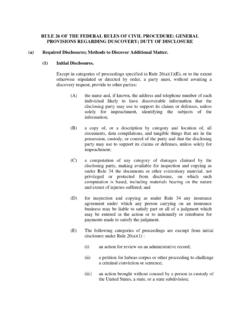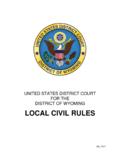Transcription of EXHIBIT 7:1 Sample Preservation Letter - …
1 EXHIBIT 7: 1 sample preservation letter [LAW FIRM]. [date/address]. Re: Notice to Preserve Electronic Evidence [Legal Matter]. Dear _____ : Our law firm represents [name] in the above legal matter in which you [your business] are [is] [will be] named as a defendant. This Letter requests your immediate action to preserve electronically stored information that may contain evidence important to the above legal matter. Briefly, the matter involves [short statement of facts in case]. This notice applies to your [company's] on- and off-site computer systems and removable electronic media plus all computer systems, services, and devices (including all remote access and wireless devices) used for your [company's] overall operation.
2 This includes, but is not limited to, e-mail and other electronic communications; electronically stored documents, records, images, graphics, recordings, spreadsheets, databases; calendars, system usage logs, contact manager information, telephone logs, internet usage files, deleted files, cache files, user information, and other data. Further, this notice applies to archives, backup and disaster recovery tapes, discs, drives, cartridges, voicemail and other data. All operating systems, software, applications, hardware, operating manuals, codes, keys and other support information needed to fully search, use, and access the electronically stored information must also be preserved.
3 The importance of immediate action cannot be overstated. Electronically stored information is easily corrupted, altered, and deleted in normal daily operations. Even booting a drive, running an application, or reviewing a document can permanently alter evidence. An important method for preserving data in its original state is to have a forensic image (mirror image or clone image) made of pertinent hard drives of both office and home computers used for business and of network servers. This image captures all current data, including the background or metadata about each document. Simply copying data to a CD-ROM or other common back- up medium is not adequate. For each captured image file, record and identify the person creating the image 2008 Thomson Delmar Learning EXHIBIT 7: 1 sample preservation letter (continued ).
4 And the date of creation. Secure the file to prevent subsequent alteration or corruption and create a chain of custody log. Once the forensic data image file is created, the pertinent computer or other device can be placed back into operation. [If known, identify any key persons', officers', supervisors', and employees' computers to which special attention for forensic imaging must be directed.]. This Preservation notice covers the above items and information between the following dates: [state dates]. Follow the above procedures to preserve electronic information created after this notice. Current law and rules of civil procedure clearly apply to the discovery of electronically stored information just as they apply to other evidence, and confirm the duty to preserve such information for discovery.
5 You [company] and your officers, employees, agents, and affiliated organizations must take all reasonable steps to preserve this information until this legal matter is finally resolved. Failure to take the necessary steps to preserve the information addressed in this Letter or other pertinent information in your possession or control may result in serious sanctions or penalties. Further, to properly fulfill your Preservation obligation, stop all scheduled data destruction, electronic shredding, rotation of backup tapes, and the sale, gift or destruction of hardware. Notify all individuals and affiliated organizations of the need and duty to take the necessary affirmatives steps to comply with the duty to preserve evidence.
6 Sincerely, [attorney/address]. 2008 Thomson Delmar Learning EXHIBIT 7:2 Form 35. Report of Parties' Planning Meeting [Caption and Names of Parties]. 1. Pursuant to 26(f), a meeting was held on (date) at (place) and was attended by: (name) for plaintiff(s). (name) for defendant(s) (party name). (name) for defendant(s) (party name). 2. Pre-discovery Disclosures. The parties [have exchanged] [will exchange by (date)] the information required by [ 26(a)(1)] [local rule _____]. 3. Discovery Plan. The parties jointly propose to the court the following discovery plan: [Use separate para- graphs or subparagraphs as necessary if parties disagree.]. Discovery will be needed on the following subjects: (brief description of subjects on which discovery will be needed).
7 Disclosure or discovery of electronically stored information should be handled as follows: (brief description of parties' proposals). The parties have agreed to an order regarding claims of privilege or of protection as trial-preparation material asserted after production as follows: (brief description of provisions of proposed order). All discovery commenced in time to be completed by (date) . [Discovery on (issue for early discovery) to be completed by (date) .]. Maximum of _____ interrogatories by each party to any other party. [Responses due _____ days after service.]. Maximum of _____ requests for admission by each party to any other party. [Responses due _____ days after service.]
8 ]. Maximum of _____ depositions by plaintiff(s) and _____ by defendant(s).Each deposition [other than of _____]. limited to maximum of _____ hours unless extended by agreement of parties. Reports from retained experts under Rule 26(a)(2) due: from plaintiff(s) by (date). from defendant(s) by (date). Supplementations under Rule 26(e) due [time(s) or interval(s)]. 4. Other Items. [Use separate paragraphs or subparagraphs as necessary if parties disagree.] The parties [request] [do not request] a conference with the court before entry of the scheduling order. (continued ). 2008 Thomson Delmar Learning EXHIBIT 7:2 Form 35. Report of Parties' Planning Meeting (continued ). The parties request a pretrial conference in (month and year).
9 Plaintiff(s) should be allowed until (date) to join additional parties and until (date) to amend the pleadings. Defendant(s) should be allowed until (date) to join additional parties and until (date) to amend the pleadings. All potentially dispositive motions should be filed by (date). Settlement [is likely] [is unlikely] [cannot be evalu- ated prior to (date)] [may be enhanced by use of the following alternative dispute resolution procedure: _____]. Final lists of witnesses and exhibits under Rule 26(a)(3) should be due from plaintiff(s) by (date). from defendant(s) by (date). Parties should have _____ days after service of final lists of witnesses and exhibits to list objections under Rule 26(a)(3).
10 The case should be ready for trial by (date) [and at this time is expected to take approximately (length of time)].[Other matters.]. Date: _____. 2008 Thomson Delmar Learning EXHIBIT 7:3 Sample Interrogatories for Electronic Discovery UNITED STATES DISTRICT COURT. DISTRICT OF [Jurisdiction]. Court File No.: _____, Plaintiff, INTERROGATORIES TO [Party Name]. v. _____, Defendant. I. Definition. The definitions below will apply to the interrogatories requested in this document A. Application An application is a collection of one or more related software programs that enable a user to enter, store, view, modify or extract information from files or databases. The term is commonly used in place of program, or software.
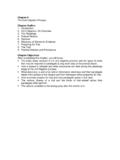

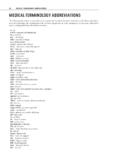

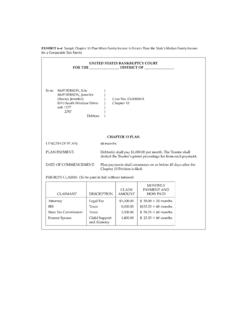
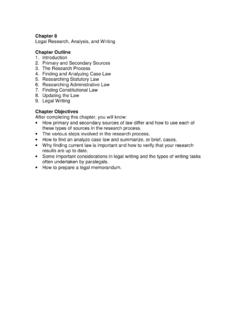
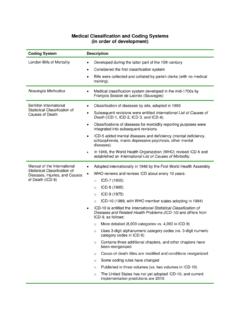
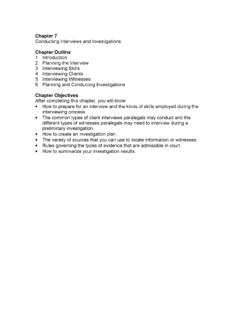

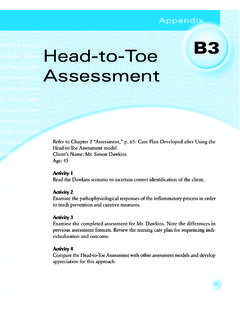


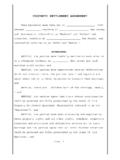
![[caption] RESPONSE TO REQUEST FOR …](/cache/preview/1/1/8/a/d/5/8/0/thumb-118ad58099489f856901e1c0e2921fe8.jpg)


